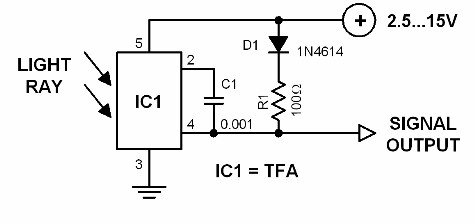Light to Frequency Converter Circuit Diagrams
Light to Frequency Converter
A light intensity to frequency converter with only four components? Yes it can be done by using the TFA1001W. This IC integrates a sensitive photodiode and a preamp. The IC itself functions as the light sensor. The current coming from the IC's open collector output is proportional to the intensity of the light striking the IC.
 |
| Light to Frequency Converter Circuit Diagrams |
Light to Frequency Converter
This IC integrates a sensitive photodiode and a preamp. The IC itself functions as the light sensor.
The current coming from the IC's open collector output is proportional to the intensity of the light striking the IC.
The capacitor C1 causes the amplifier circuit to oscillate. The oscillation frequency is dependent on the light intensity and can be between 100 Hz and 100 kHz when the supply voltage is kept constant at 7.5 volts.
Logically, when the supply voltage is of different value, the frequency range will also change. The output signal appears in a form of a squarewave.
The output impedance of the circuit is quite high, that is why the circuit must be connected to succeeding stages with impedance of not less than 50 ohms.
Why convert the light's intensity to frequency? The conversion makes it easy to remotely measure the intensity level.
Remote measurement is telemetry, and is very important in many applications. The signal can be channelled to a receiver through a coaxial cable.
It can also be used to modulate a transmitter thus enabling the measured value to be transmitted over very long distances.
If the transmitted radio signal is repeated via a satellite, the telemetry can be done worldwide.
